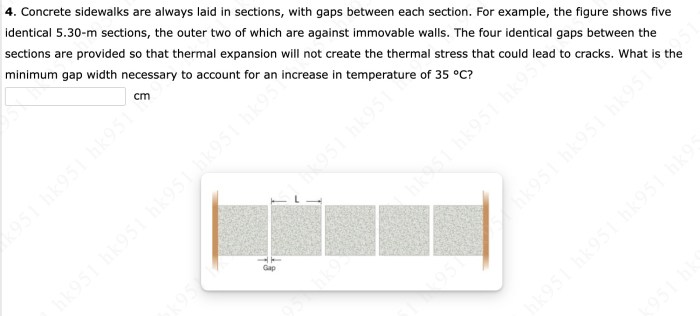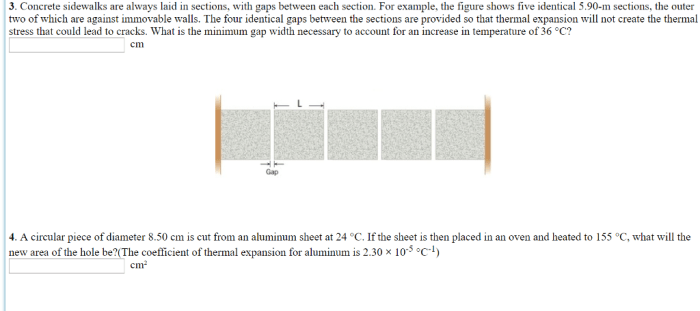Concrete sidewalks are always laid in sections, and for good reason. This unique construction method offers numerous advantages, from enhanced durability to improved accessibility. Delve into the world of sectional sidewalks, exploring their composition, installation techniques, design considerations, and maintenance practices.
The use of sectional construction in sidewalks is a testament to its effectiveness. By dividing the sidewalk into smaller segments, it allows for controlled expansion and contraction, minimizing the risk of cracking and other damage. This approach also facilitates repairs and replacements, ensuring the longevity of the sidewalk.
Concrete Sidewalk Composition and Characteristics

Concrete sidewalks are composed primarily of cement, sand, gravel, and water. The cement acts as a binder, holding the other components together and creating a solid mass. The sand and gravel provide strength and durability, while the water helps to hydrate the cement and create a workable mixture.
Various additives and reinforcements can be incorporated into the concrete to enhance its properties, such as fly ash to improve workability and reduce shrinkage, or steel fibers to increase tensile strength and impact resistance.
Concrete sidewalks typically have a thickness of 4-6 inches and a width of 4-8 feet. The thickness is determined by the expected traffic load, while the width is determined by the space available and the desired pedestrian flow.
Sectional Construction of Sidewalks

Concrete sidewalks are constructed in sections to allow for expansion and contraction due to temperature changes. Expansion joints are placed at regular intervals along the sidewalk to prevent cracking, while control joints are placed to create a weakened plane and guide cracking in a controlled manner.
Different types of joints are used depending on the specific application and requirements.
Installation Process and Considerations

The installation of concrete sidewalks involves several steps. First, the subgrade is prepared by removing any existing vegetation and compacting the soil. Next, a form is set up to define the shape and size of the sidewalk. The concrete is then poured into the form and leveled.
Finally, the concrete is finished by smoothing the surface and removing any excess material.
Proper subgrade preparation and compaction are crucial for the long-term performance of the sidewalk. The subgrade must be stable and well-drained to prevent settlement and cracking. The concrete must be poured and finished carefully to ensure a smooth and level surface.
Design Considerations for Sectional Sidewalks
When designing sectional sidewalks, several factors must be considered. These include the traffic load, environmental conditions, and aesthetic requirements. The traffic load determines the thickness and reinforcement required for the sidewalk. The environmental conditions, such as freeze-thaw cycles and exposure to chemicals, must also be considered when selecting the appropriate concrete mix and design.
The aesthetic requirements of the sidewalk should also be considered. The color, texture, and pattern of the concrete can be customized to match the surrounding environment. ADA accessibility guidelines must also be considered when designing sidewalks to ensure that they are accessible to people with disabilities.
Maintenance and Repair of Sectional Sidewalks

Concrete sidewalks require regular maintenance to keep them in good condition. This includes sweeping and cleaning to remove dirt and debris, and sealing cracks and joints to prevent water penetration. Sidewalks may also need to be repaired from time to time due to damage caused by wear and tear, tree roots, or other factors.
Cracks and spalling are common problems that can occur in concrete sidewalks. Cracks can be repaired by filling them with a concrete patching compound. Spalling, which is the breaking away of the concrete surface, can be repaired by removing the damaged concrete and replacing it with new concrete.
Expert Answers: Concrete Sidewalks Are Always Laid In Sections
Why are concrete sidewalks always laid in sections?
Sectional construction allows for controlled expansion and contraction, reducing the risk of cracking and other damage.
What are the advantages of using expansion joints in concrete sidewalks?
Expansion joints allow the sidewalk to expand and contract without cracking, accommodating temperature changes and ground movement.
How thick should a concrete sidewalk be?
The typical thickness of a concrete sidewalk ranges from 4 to 6 inches, depending on factors such as traffic load and soil conditions.